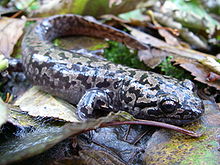Willapa National Wildlife Refuge
Coordinates: 46 ° 26 ′ 30 ″ N , 123 ° 58 ′ 0 ″ W.
Willapa National Wildlife Refuge is an area of over 60 square kilometers in the southwest of the US state Washington . It is located on Willapa Bay , one of the most pristine estuaries in the United States. With 673 square kilometers of water, Willapa Bay is the second largest estuary on the US Pacific coast. The sanctuary is managed by the US Fish & Wildlife Service and protects numerous species of wildlife. Most importantly, it provides habitat for hundreds of thousands of migratory birds and waterfowl, including such endangered species as the Marmelalk and the Kentish Plover .
geography
The Willapa Wildlife Refuge comprises the island of Long Island , coasts and bodies of water at the southern end of Willpa Bay and the northern tip of the Long Beach Peninsula called Leadbetter Point . Long Island is a unique 22 square kilometer island in Willapa Bay and the largest island in an estuary on the US Pacific coast. The reserve is divided into four units , the Reikkola Unit , Leadbetter Unit , Porter Point Unit and Long Island .
history
The Chinook , Chehalis, and Kwalhioqua tribes lived and hunted in the area for at least 2,000 years. The game and various marine animals, especially salmon, nourished the peoples throughout the year. Today the First Nations use Long Island for spiritual and cultural festivals. In 1788, the explorer John Meares named the northern tip of the Long Beach Peninsula Low Point . In 1852 it was renamed Leadbetter Point in honor of Danville Leadbetter , a US coastal survey officer . Logging began on Long Island around 1900. The reserve was established in 1937, at a time when other estuaries in the United States were being destroyed by dykes, drainage and pollution.
Flora and fauna
The Willapa Wildlife Refuge protects a number of unique ecosystems such as salt marshes , tidal pools , wet meadows , coastal rainforest and sand dunes from destruction. The sandbanks in the bay provide space for seals and serve as resting places for migratory birds. Brown pelicans come to the bay in summer and autumn . In addition to the endangered Marmelalk and the Kentish Plover , the important animal species include bald eagles , wild geese and blue herons . Black bears , elk , bobcats , spotted owls , flying squirrels , tree frogs and silver haired bats live in the forests . Willapa Bay has more amphibian diversity than any other wildlife refuge in Washington state.
The resident salamander species include the giant cross-toothed newt Dicamptodon tenebrosus , the Olympus cross-toothed newt , Eschscholtz salamander , Dunn's lungless salamander , Van Dyke's salamander and western redback salamander . Some endangered species of turtles such as the loggerhead turtle , green turtle and leatherback turtle have a refuge here.
Leadbetter Point on the northern tip of the Long Beach Peninsula consists of ever-changing sand dunes, on which beach grass , lupins , wild strawberries and verbenas grow. The winter rains create freshwater pools on which willows and other freshwater plants grow. A light pine forest grows further in the interior of the peninsula. The dunes and salt marshes of Leadbetter Point provide food and thus a habitat for 100 different bird species. The Leadbetter Point State Park borders directly south of the Wildlife Refuge .
Long Iceland has a 110-hectare, Cedar Grove -called coastal rain forest with 900 year old giant trees of life . The island with its rich vegetation provides a habitat for a wide variety of animals, such as black bear, elk, mule deer , beaver and river otter . The trees are nesting places for Marmelalk, Bald Eagle and Blue Heron. Dead trees provide nesting sites for helmet woodpeckers , flying squirrels and spotted owls. Rare salamander species live in fallen trees. The nutrient-rich marine life around Long Island is home to oysters, crabs, salmon and rainbow trout, and numerous other marine animals. The extensive seagrass stocks in western Long Island are nurseries for juveniles of Pacific herring and salmon. The grasslands of the Riekkola Unit at the southern end of the bay provide space for numerous birds such as Canada geese , ducks and other shorebirds. In the spring the meadows are populated by songbirds. Bobcats, elk and black bears live in the neighboring forests. The Porter Point Unit contains freshwater marshes that are home to amphibians, waterfowl, and other animals.
tourism
At the southern end of Willapa Bay is the Refuge Headquarters , which provides information about the flora and fauna of the reserve. There are several trails and simple campsites in the Wildlife Refuge itself. It is also accessible by boat. Even fishing and hunting licenses can be purchased for certain areas.
literature
- John Kruse: Great Places: Washington. A Recreational Guide to Washington's Public Lands and Historic Places for Birding, Hiking, Photography, Fishing, Hunting, and Camping. Wilderness Adventures Press, 2009, ISBN 978-1932098693
Web links
- Homepage of the Willapa Bay National Wildlife Refuge
- http://www.fws.gov/willapa/wildlife/wildlife.html
Individual evidence
- ↑ http://www.npwrc.usgs.gov/resource/birds/chekbird/r1/willrept.htm (accessed on September 12, 2010)


